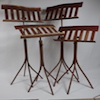Can anyone advise on a way to closely control the temperature of an electric iron for use in hammer veneering? The lowest settings on the commercial irons I've used produce quite high temperatures, along with wide temperature swings between thermostat-on and -off points. I find this makes work on larger panels dicey.
It has crossed my mind to try using a router speed controller to limit the current to the iron, reasoning that this might limit the iron's temperature without damaging anything or starting a fire. But I'm not sure that I really know this would be effective and safe.
Alternatively, irons with better (continuously variable?) temperature controls than mine could exist and I just don't know about them. Any advice appreciated. Thanks.




 Reply With Quote
Reply With Quote


